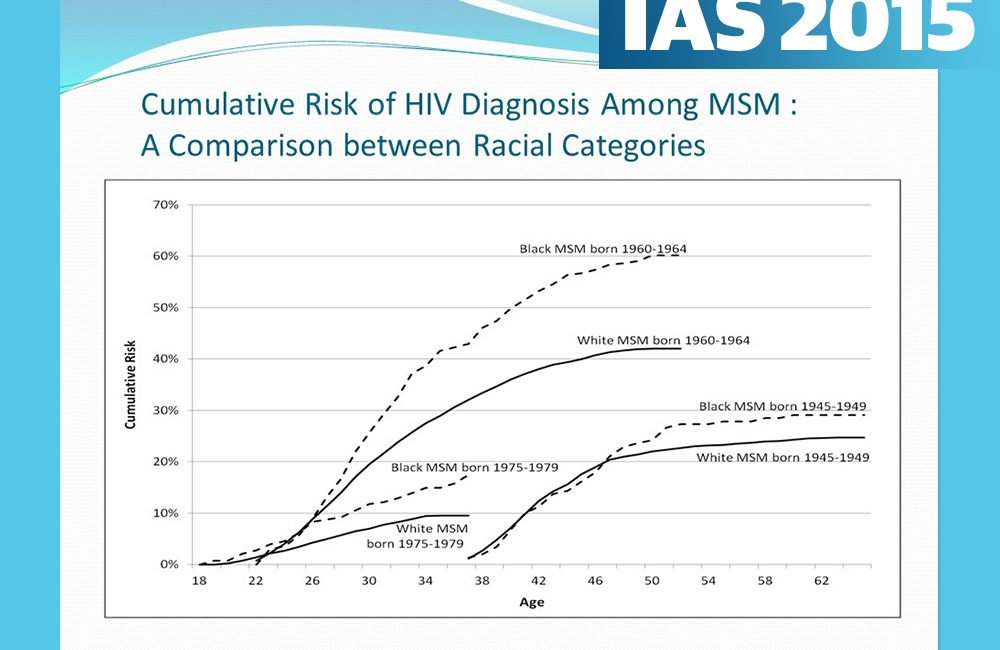
An innovative analysis of HIV trends in the Seattle area has found that gay men who were born in the early 1960s had the highest lifetime risk of acquiring HIV, but that this risk has declined dramatically in subsequent generations. While black gay men born in the 1970s and 1980s have a much lower risk of acquiring HIV than their forebears, racial disparities remain stark.
Presenting the results on Tuesday to the Eighth International AIDS Society Conference on HIV Pathogenesis, Treatment and Prevention (IAS 2015) in Vancouver, Galant au Chan of the University of Washington said that the results are probably not generalisable across the United States.
Seattle has high-quality services, good access to effective HIV treatment and a well-informed population. Dr Chan is planning to conduct similar analyses of the epidemic in other parts of the country to compare results.
Nationally, the incidence of new HIV infections in young gay men – especially young black gay men – is unacceptably high. New diagnoses are rising in this age group.
The analysis used a life table approach to describe the cumulative risk of HIV infection in groups of men who have sex with men (MSM) born around the same time. The researchers looked at HIV diagnoses throughout the HIV epidemic in men who have sex with men living in King County, the area which includes the city of Seattle. Undiagnosed infections were not included.
White gay men
The first age cohort examined are white men who were born in 1945-49. They would have been in their thirties when the AIDS epidemic began in the 1980s and those still alive are now in their late sixties or seventies.
For this generation, 5% had HIV by the time they were 40 years old, 22% by the age of 50 and 24% by the age of 60. After this, not many extra men acquired HIV.
The risk of ever acquiring HIV was significantly higher for the cohorts of gay men born in the 1950s. The group of men hit hardest by the epidemic are those born in 1960-64. They were in their late teens or early twenties when AIDS began and the survivors are now in their fifties.
In this age group, 20% had HIV by the age of 30, 35% by the age of 40, and 42% by the age of 50.
But these lifetime risks have declined significantly in subsequent generations. For example, those born in 1975-79 were in their late teens or early twenties when combination therapy was introduced.
They are now in their late thirties and just under 10% have HIV. There are signs that this total may have reached a plateau.
The figures on those born in the 1980s and early 1990s are more encouraging although there are obviously fewer data on the youngest generations.
Black gay men
A similar pattern was seen in black gay men, but with interesting trends in terms of racial inequalities.
Firstly, the cohort of men born in 1945-49. For approximately the first decade of the epidemic, when these men were aged 38 to 48, their risk of infection was identical to that of white gay men. However, racial disparities then began to emerge, so that 24% had HIV by the age of 50 and 29% by the age of 60. This is a few percentage points higher than in white men.
The racial disparities were extremely stark in the hardest hit generation, those born in 1960-64. Whereas 35% of white gay men had HIV by the age of 40, this figure was 48% in black gay men. Further, 42% of white men had HIV by the age of 50, considerably fewer than the 60% of black gay men.
The largest absolute reduction in the risk of infection has occurred in subsequent generations of black gay men. In the cohort of black men born in 1975-79 (now in their late thirties), around 17% now have HIV. This is well under half the equivalent figure for men born in 1960-64 when they were in their late thirties.
But the racial disparity has, if anything, widened. The 17% figure should also be compared with the 10% in white men of the same generation.
Concluding, Chan said that the Seattle area “may be ageing out of the HIV epidemic”.
Chan G et al. Dramatic declines in lifetime HIV risk and persistence of racial disparities among men who have sex with men (MSM) in King County, Washington, USA. 8th International AIDS Society Conference on HIV Pathogenesis, Treatment, and Prevention (IAS 2015), Vancouver, abstract TUAC0303, 2015.
You can download the slides of this presentation from the conference website.
A webcast of this presentation is available on the conference YouTube channel.
Where available, you can view details of sessions, view abstracts, download presentation slides and find webcasts using the conference 'Programme at a Glance' tool.
You can also download a PDF of the abstract book from the conference website.
